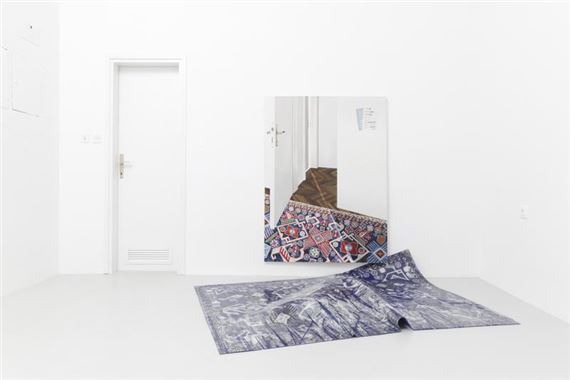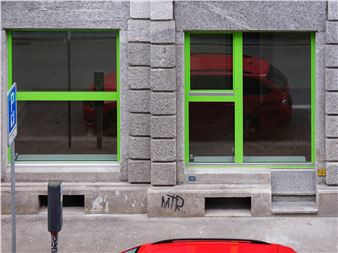Ulla Žibert: Can Have So Forget About Sea Swallowing Plastic
Artist Ulla Žibert presents herself in R SPACE with a solo exhibition enigmatically entitled Can have so forget about sea swallowing plastic. It is a set-up that is essentially an attempt to visualise the uncertain spirit of the time. The starting point of the exhibition is a failed monologue that reveals, on the one hand, selfish human intentions and, on the other, the concern and helplessness of the individual in the face of the irreparable damage and devastating consequences of the global environmental crisis. It exposes that which is no longer smouldering beneath the surface but burns above it, becoming irrepressibly omnipresent and penetrating the realm of the everyday. The motif of the everyday is also frequently taken up by the artist in her practice, as she understands this concept to be inseparable from the issues of contemporary society, despite its banal associations. With a mimetic stroke, but at the same time with an uncomfortably distorted perspective and thoughtfully painted shadows, Žibert brings tension to the luxuriously trivial scenes of everyday life and creates a gap that leads to a reassessment of what is seen. Even if the painting seems predictable, the otherwise convincing illusion eludes her viewer's re-analysis and the possibility of a different reading opens up.
The artist uses pictorial approaches to open up new semantic clues, particularly through the shaping and reshaping of the shadow, which she uses as a tool to generate alternative information about what we are looking at. This is also the case in the present spatial set-up, which consists of a painting depicting an interior and an object that spreads out from the canvas as an extension of the painting and occupies the gallery space. In the clean interior depicted in the painting, we notice a poster that is about to come off, its incised text casting a shadow on the wall behind it. The question carved into the poster (Can we have sex? So I can forget about sea turtles swallowing plastic bags) and its shadow, which can also be read as an answer (Can have so forget about sea swallowing plastic), create a certain dimension of paradox in both possible readings; the painting becomes a riddle of an escapist and anxious stepping away from the problem of global pollution and at the same time awareness of the consequences of the hyper-consumption logic of the existing economic system. The image of a beautiful decorative carpet can be just that, an isolated and exuberant detail from a scene that gives the impression of homeliness. The artist potentiates it by repeating the carpet in the space, while at the same time explicitly distancing herself from it. An object whose surface is unpredictable and no longer soft enough, but an unpleasantly crumbling mass of sharp felt, becomes a foreign body that creates a cut and a step away from whatever meaning the image of the carpet may have had before.

Recommended for you
Artist Ulla Žibert presents herself in R SPACE with a solo exhibition enigmatically entitled Can have so forget about sea swallowing plastic. It is a set-up that is essentially an attempt to visualise the uncertain spirit of the time. The starting point of the exhibition is a failed monologue that reveals, on the one hand, selfish human intentions and, on the other, the concern and helplessness of the individual in the face of the irreparable damage and devastating consequences of the global environmental crisis. It exposes that which is no longer smouldering beneath the surface but burns above it, becoming irrepressibly omnipresent and penetrating the realm of the everyday. The motif of the everyday is also frequently taken up by the artist in her practice, as she understands this concept to be inseparable from the issues of contemporary society, despite its banal associations. With a mimetic stroke, but at the same time with an uncomfortably distorted perspective and thoughtfully painted shadows, Žibert brings tension to the luxuriously trivial scenes of everyday life and creates a gap that leads to a reassessment of what is seen. Even if the painting seems predictable, the otherwise convincing illusion eludes her viewer's re-analysis and the possibility of a different reading opens up.
The artist uses pictorial approaches to open up new semantic clues, particularly through the shaping and reshaping of the shadow, which she uses as a tool to generate alternative information about what we are looking at. This is also the case in the present spatial set-up, which consists of a painting depicting an interior and an object that spreads out from the canvas as an extension of the painting and occupies the gallery space. In the clean interior depicted in the painting, we notice a poster that is about to come off, its incised text casting a shadow on the wall behind it. The question carved into the poster (Can we have sex? So I can forget about sea turtles swallowing plastic bags) and its shadow, which can also be read as an answer (Can have so forget about sea swallowing plastic), create a certain dimension of paradox in both possible readings; the painting becomes a riddle of an escapist and anxious stepping away from the problem of global pollution and at the same time awareness of the consequences of the hyper-consumption logic of the existing economic system. The image of a beautiful decorative carpet can be just that, an isolated and exuberant detail from a scene that gives the impression of homeliness. The artist potentiates it by repeating the carpet in the space, while at the same time explicitly distancing herself from it. An object whose surface is unpredictable and no longer soft enough, but an unpleasantly crumbling mass of sharp felt, becomes a foreign body that creates a cut and a step away from whatever meaning the image of the carpet may have had before.

 ARTISTS
ARTISTS
















